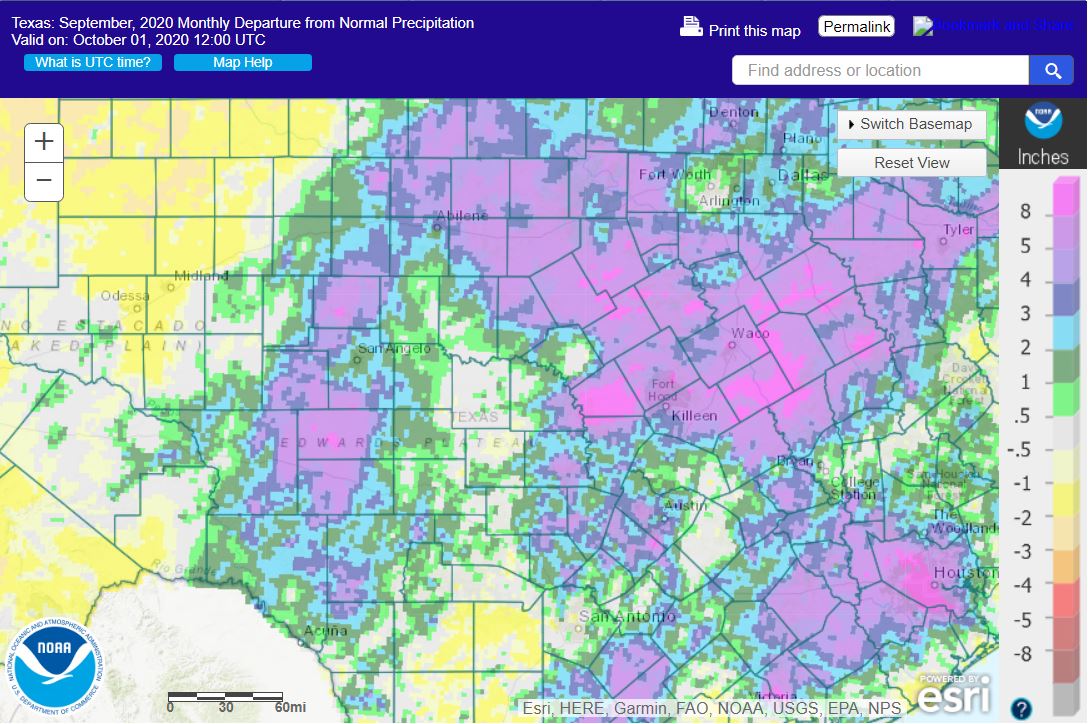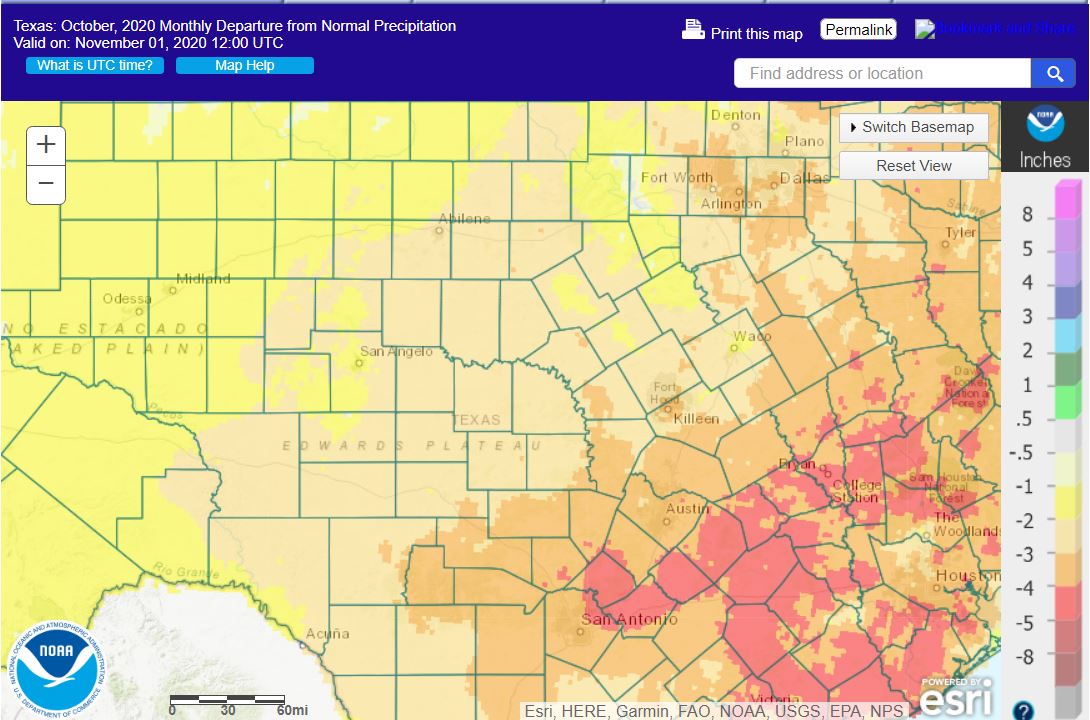
Texas Wildflower Report: 2020 Spring Outlook
Copyright © 2021 by EquipU LLC
Overview
As of March 10, 2021, it appears that we are on track for a “hit and miss” season with bloom times close to or slightly later depending on overall temperatures during the rest of March. Most all areas in Texas have some locations that received normal to above normal rainfall in September 2020 to support some germination of seeds, but the rainfall throughout Texas for October and November was below normal with some exceptions. The below normal rainfall for October and November could be a major limiting factor for the number of plants that are actually out there. The winter rainfall although below normal in most areas should have been sufficient to sustain rosette growth. Some locations like some counties in the Hill Country received close to normal rainfall in the past 60 days. Winter temperatures for December through February were about one degree below average. The below normal temperature during the winter months might have been enough to satisfy the “vernalization” requirement for winter annuals.
Fall Rainfall
September Rainfall was close to normal or well above normal for all major wildflower areas with the exception of Big Bend. The big question is whether this rainfall resulted in germination of plants and how many. Nearly all of our spring wildflower annuals including bluebonnets germinate in the fall from September through November until the ground is too cold to support germination. My research has shown that rainfall in October is critical for an above average season. All of the best years I have experienced resulted when the rainfall in October was normal to above normal. That said, it is also important to have normal rainfall and normal temperature ranges during the winter months.

Figure 1: September 2020 Departure from Normal Rainfall – blue to pink/violet is above normal rainfall

Figure 2: October 2020 Departure from Normal Rainfall – yellow to red-orange is below normal
Winter Rainfall
The most crucial time for rainfall in the winter is during the months of January and February. The 60-day departure from normal rainfall as of 3/9/2021 shows most areas with slightly below average rainfall with the exception of some counties in the Hill Country and the Big Bend areas. This is a negative factor for an average season, because the winter rainfall is crucial in helping the plants develop root systems that will support large healthy plants with lots of blooms. Anyone who has grown any plant from seed, knows that healthy roots yield larger and healthier plants.

Figure 3: 60-day Departure from Normal Rainfall as of 3/9/2021 – no color is normal rainfall – yellow is below normal rainfall
Winter Temperatures
Since 2000, our winter temperatures have trended warmer which has resulted in early blooms and in years with below normal rainfall shorter bloom times. Cold winters are important especially for cool season plants like our Texas bluebonnets. Studies have shown that bluebonnets need an extended period of cold temperatures below 40 degrees to help stimulate better blooms in spring. The temperatures for the December through February months were slightly below average which should have been sufficient for at least the bluebonnet plants. Cooler temperatures from February through April tend to result in later and longer bloom times, warmer temperatures tend to result in early and shorter bloom times.
Conclusion
There are two negative factors – below normal October rainfall and below normal winter rainfall that make it difficult to forecast even an average season for most areas. I think the only hope is that the September rainfall was sufficient to result in enough seeds germinating into plants that remained healthy and viable until now. I tend to forecast on the conservative sides trying to promise less and hopefully more will develop. If I was able to get out this season, I would use the September and 60-day rainfall maps to help pick out spots to explore. I would also check for scouting reports that might give us a chance to know where the plants are.
References
Climate at a Glance: https://www.ncdc.noaa.gov/cag/
NOAA Observed Precipitation: https://water.weather.gov/precip/
About this Outlook
This Outlook is just a guide and does not guarantee that the reader will find displays of Texas bluebonnets/wildflowers along any of the areas mentioned. It is hoped that the information shared here will encourage you, the reader, to safely and respectfully venture out to enjoy the wonder and beauty of our state flower and the many other wildflowers in Texas. For current reports on bluebonnet and other wildflower sightings visit our Facebook page – Texas Wildflower Report.
When you do venture out to enjoy our Texas Bluebonnets and other wildflowers in bloom, please travel safely and be respectful of the private property of others. We do not encourage nor do we condone trespassing on private property to get that annual “kids in the bluebonnets” photo or any photo. The Texas Department of Public Safety provides some important guidelines on how to safely and legally enjoy viewing and photographing our Texas Wildflowers. You are strongly encouraged to read those guidelines before venturing out to explore.
WildflowerHaven.com is a for-profit organization, but we do attempt to provide these and many other sources of information without charge. If you would like to help fund our efforts please consider making a small donation via PayPal.
Disclaimer: The information contained in this book is provided on an “as is” basis, without warranty. Although the author and publisher have made an effort to ensure the accuracy of the information, they accept no responsibility for any loss, injury or inconvenience sustained by any person using this book.
Copyright © 2021 by EquipU LLC
All rights reserved. No part of this publication except as specified below may be reproduced in any form or by any electronic or mechanical means, including, but not limited to, information storage and retrieval systems, without the express permission from the publisher with the exception that a reviewer may quote brief passages in a review. EquipU LLC grants the user/reader of this publication the right to share copies of this publication as-is and without modification.
The above copyright does not apply to specific data/maps sourced from: